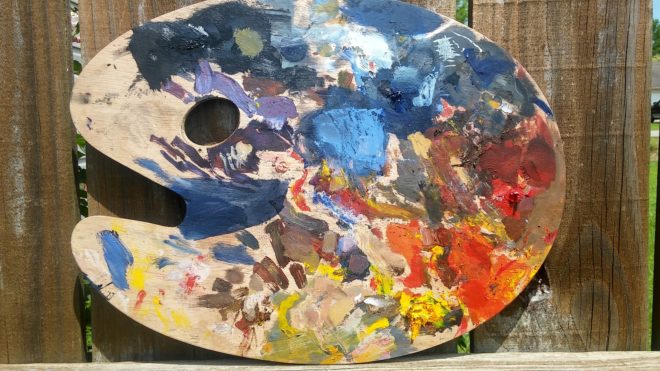Podcast Spotlight: The Lonely Palette

Last updated on January 10th, 2018
Art tends to be a standoffish and a difficult hobby to pick up for newbies. But it doesn’t have to. Tamar Avishai is looking to make the world of art more accessible for the everyday layman to appreciate with her podcast, The Lonely Palette.
When I first spoke with Tamar about The Lonely Palette and the “why create a podcast” question inevitably came up, she claimed, “there are two words associated with art history: boring and snooty. This podcast is neither.” A bold claim, but The Lonely Palette podcast delivers. Think about walking through an art museum with a good friend, who just happens to be insanely knowledgeable with the history and culture art brings, leaving out the snoot and condescending attitude most of us attribute to the art world at large. That’s what you get with The Lonely Palette.
It’s an art podcast for “not art people.”
As I mentioned, I got a chance to speak with Tamar about The Lonely Palette, the problems with the intimidating art culture, and how her podcast is helping to break down the artificial walls. See below for our Q&A.
Discover Pods: What’s your podcast about?
Tamar: Making art history fun and accessible for the masses, one painting at a time.
DP: How did you think of podcasts as a medium to discuss art?
Tamar: I get this question a lot, and the truth is, it never occurred to me that audio would be such a nutty medium to discuss art for a few reasons. First, museums have used audio guides for years as a means of bringing sound with you along for the museum ride, and having a voice in your ear to explain the object at hand. Of course, the operative phrase there is “at hand”, and I assume that folks will pull up the image at some point when they’re listening to the show. But some listeners have told me that it’s not always necessary, because, frankly, audio is one of the most visual mediums I can imagine because of the quality of the writing (and you rarely hear anyone complain about books not having pictures…). So much work goes into audio writing and creating visual descriptions – we forget how much of our mind’s eye we use when we listen to good audio stories. I don’t know about you, but my imagination goes into overdrive when I listen to the radio, to the point where I’m disappointed when I see what my favorite hosts actually look like. To that end, I love gathering the descriptions of the objects that I use at the top of every episode. People are so good at describing art when they think they aren’t – the similes and associations are so wonderful at engaging the mind’s eye of the listener. Plus, it’s important for the average art-viewer to appreciate that the texture of a Monet really does look like a sponge, and that they’re not neophytes for thinking that too.
DP: On your website, and on your recommended starting episode (Episode 0), you discuss removing the intimidation of art. In your opinion, how does this happen?
Tamar: It’s not easy – art history has a pretty established brand of academic erudition, and they’re not letting go of it any time soon. Museums, too, have long appealed to the kinds of people who already want to go to them, or at least dabble in some high-class culture for the day, and offer more to people who already know something about the objects. All of this adds up to a discipline that many feel is too high a barrier for entry, or not wanting to join a club that wouldn’t have them as a member. To that end, what I do in the podcast is really all I ever wanted someone to do for me: focus on the storytelling, take a step away from the rarified, priceless object, and return to the messy, hot-headed, struggling artist who painted it, because plenty more people can relate to that person. Art history is simply history, as fascinating and subjective and head-scratching as any other expression of human experience. And I try to emphasize this in the podcast at every opportunity: I weave in pop culture references, break down complicated ideas with analogies, and, most of all, highlight the voices at the top that I mentioned above. I interview people who are self-professed “not art people” (if I had a nickel for everyone I’ve met who described themselves that way I wouldn’t need Patreon), and ask them what about the object speaks to them. This then gives me the opportunity to help unpack the object through an art historical lens, based on what someone is already interested in. I think this really helps people see this stuff as interesting, rather than intimidating.
DP: What challenges are there as a podcast, audio only, discussing something visual, like art?
Tamar: Well, like I said above, people need a little bit of encouragement to get past their own skepticism that art can be explained aurally. In a perfect world, everyone has the opportunity to look at the object as they listen, but then they can’t do that in their cars, the very best place to listen to podcasts. So I try to make the story itself the most compelling part of the show, and hope that it holds up whether or not someone can see the image or not. I’ve had some listeners tell me that they’re a little disappointed when they actually see the image because the visitor descriptions, and then my own, were so visually exciting that it was almost a bummer to limit the object to what it actually looks like. I feel like that’s enormously high praise.
DP: Do you recommend listeners have a visual aid to accompany their listening?
Tamar: I do. It’s not entirely necessary, but it’s like reading the book before class. It just helps follow the conversation.
DP: What challenges do you face as an indie podcaster?
Tamar: Oh man. Not to be too on-brand, but it’s lonely! I’m a one-woman band, so I end up doing a lot of fretting before every episode is released, even if it’s something I believe is good. I don’t have an editorial board giving me feedback as I go, which is at once liberating and terrifying. It’s hard to completely trust that something is good until it gets some external feedback, and it’s tough to get that when my own working timeline is so idiosyncratic. Also, of course, the money thing. I produce this show – at least for now – on the margins of a full-time job, so it’s been stressful to fit it all in and account for all the switching costs. And when I’m not working at work or working on the show, I’m hustling: networking, getting the brand out there, engaging with other Boston-area indie podcasters, pitching to established shows. One of the real problems – the loneliness – has been mostly alleviated by co-founding a podcast collective, Hub & Spoke, with the shows Soonish and Ministry of Ideas (and most recently, Hi-Phi Nation). We figured, why hustle alone when we can hustle together?
DP: What are your top 5 podcasts?
Tamar: Not counting the ones in Hub & Spoke, I’d have to say that my staples are The Daily, Nancy, Homecoming, Song Exploder, and (I never miss an ep:) Again with This: Beverly Hills 90210.
DP: Where can listeners find you?
Tamar: www.thelonelypalette.com
Twitter: @lonelypalette
Instagram @thelonelypalette
Facebook @thelonelypalette
H&S Twitter: @hubspokeaudio













Comments
Comments are closed.